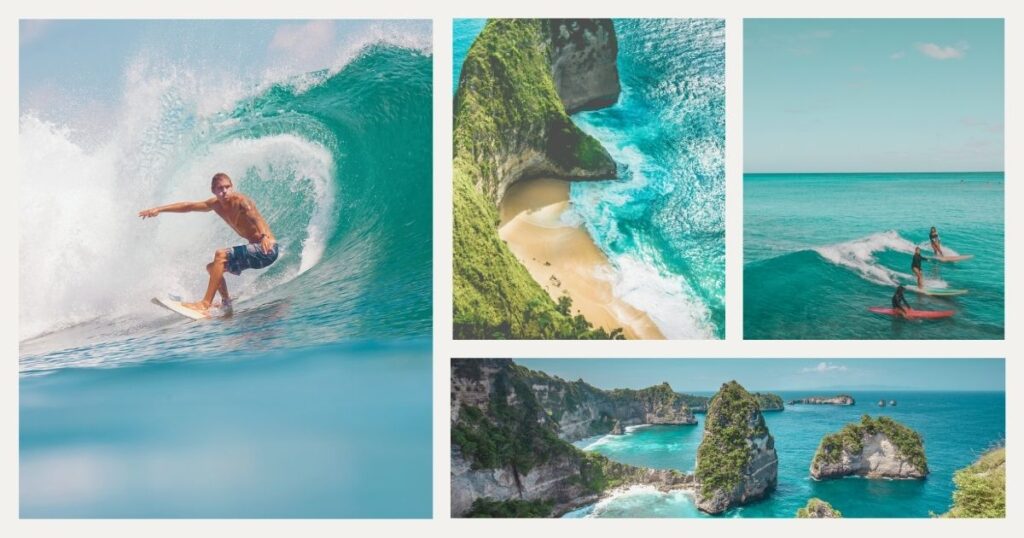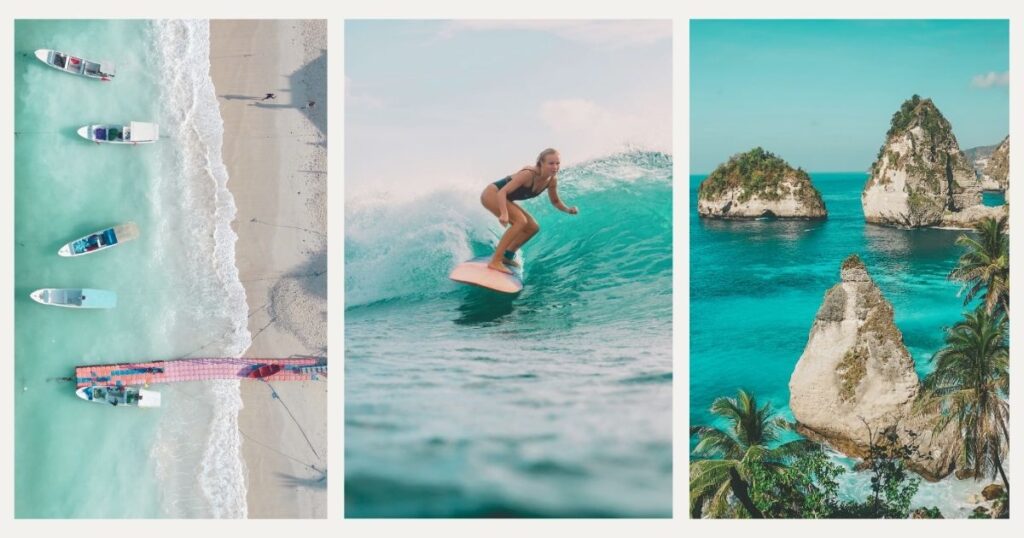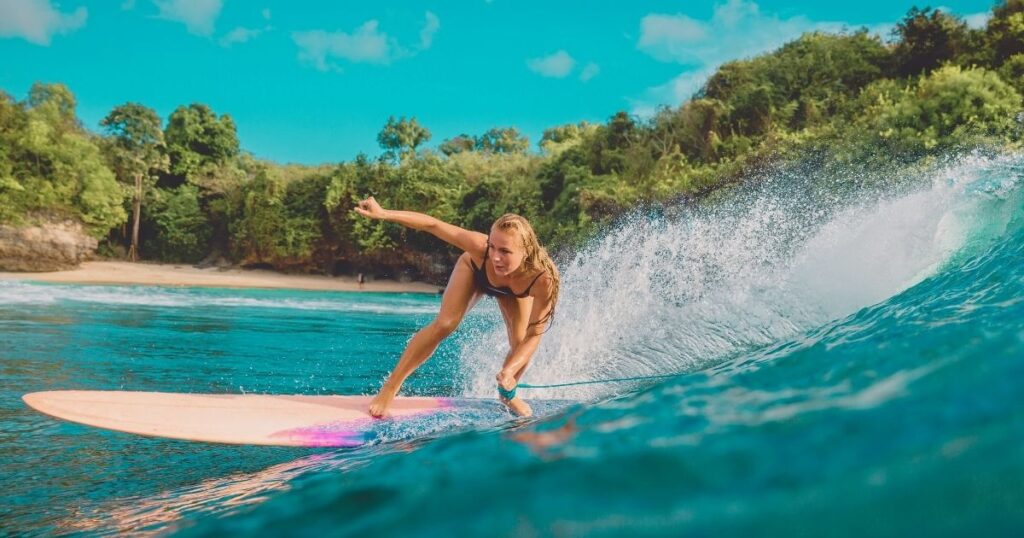Picture this: you’ve just finished a productive morning responding to emails from a beachfront café, and now it’s time to paddle out into crystal-clear waters for your afternoon surf lesson. This isn’t just a dream—it’s the reality that awaits digital nomads at surf camps across Bali. The island’s perfect waves, warm waters, and thriving remote work community make it an ideal destination for combining professional growth with surf progression.
Whether you’re a complete beginner eager to catch your first wave or an intermediate surfer looking to refine your technique, Bali’s diverse surf camp scene offers something for every skill level and budget. From the gentle breaks of Kuta to the more challenging waves of Uluwatu, you’ll find the perfect environment to develop your surfing skills while maintaining your remote work routine. Let’s dive into the best surf camps in Bali!
Why choose a surf camp in Bali for your digital nomad journey

Bali has earned its reputation as the ultimate destination for combining work and surf, and choosing a surf camp in Bali offers unique advantages that individual surf lessons simply can’t match. The structured approach of surf camps provides consistent progression, while the community aspect connects you with like-minded individuals who share your passion for both professional success and ocean adventures.
The island’s year-round warm climate means you can surf comfortably without thick wetsuits, making it easier to squeeze in sessions before important video calls or after long work days. Most surf camps understand the digital nomad lifestyle and offer flexible scheduling that accommodates different time zones and work commitments.
Perfect learning conditions for all skill levels
Bali’s coastline offers diverse surf conditions, from forgiving white water breaks perfect for beginners to powerful reef breaks that challenge experienced surfers. The warm tropical waters maintain comfortable temperatures year-round, while consistent swells provide reliable waves for surf camp participants.
🌟 Pro tip: the best surf conditions typically occur during the dry season (April to October), when offshore winds create clean, well-formed waves perfect for learning and progression.
Vibrant digital nomad community
The intersection of surf culture and remote work has created a unique ecosystem in Bali. Many surf camps cater specifically to digital nomads, offering high-speed wifi, dedicated workspaces, and scheduling flexibility that allows you to balance professional responsibilities with surf progression.
💡Did you know? Canggu alone hosts over 50 coworking spaces, many of which offer special rates for surf camp participants, creating seamless transitions between work and surf sessions.
Top surf camp Bali destinations for digital nomads

Selecting the right location for your surf camp in Bali depends on your skill level, work requirements, and lifestyle preferences. Each area offers distinct advantages, from beginner-friendly breaks to advanced waves that will challenge your progression.
Canggu: the digital nomad surf capital
Canggu has emerged as the premier destination for digital nomads seeking quality surf instruction alongside excellent work infrastructure. The area features consistent waves suitable for beginners through intermediate surfers, while abundant coworking spaces, reliable internet, and vibrant café culture make it easy to maintain professional productivity.
Popular surf camps in Canggu offer comprehensive packages including accommodation, surf lessons, board rentals, and coworking access. The waves at Echo Beach and Batu Bolong provide perfect conditions, with gentle inside sections for beginners and challenging outside peaks for advancing surfers. This makes it an amazing surf camp in Bali.
Uluwatu: advanced surf training paradise
For intermediate to advanced surfers seeking to push their limits, Uluwatu represents the pinnacle of Balinese surf experiences. The powerful reef breaks demand respect and skill, making it ideal for surf camps focused on progression and technique refinement.
Uluwatu surf camps typically offer smaller group sizes and more personalized instruction. The dramatic clifftop setting provides inspiring work environments for digital nomads, though the remote location requires careful planning for reliable internet connectivity.
🌟 Pro tip: ensure your accommodation includes robust internet backup solutions, as Uluwatu’s clifftop locations can sometimes experience connectivity challenges during storms.
Kuta and Seminyak: beginner-friendly options
The soft sand beaches of Kuta offer forgiving conditions perfect for first-time surfers, while Seminyak provides a more upscale experience with luxury accommodations. These areas excel at introducing complete beginners to surfing fundamentals in safe, controlled environments.
Surf camps in these areas focus heavily on water safety, proper technique development, and building confidence in the water. The beach breaks provide consistent waves without the dangers associated with reef breaks.
Essential considerations for choosing your surf camp experience

Selecting the right surf camp in Bali requires careful evaluation of several factors that will significantly impact your overall experience. Beyond wave quality and instruction level, consider how well each camp accommodates your specific needs as a digital nomad.
Internet connectivity and work infrastructure
Reliable internet access isn’t just convenient—it’s essential for maintaining professional commitments while pursuing surf progression. The best surf camps for digital nomads provide high-speed wifi in accommodation areas, backup connectivity options, and dedicated workspaces for important calls.
Look for camps that offer Ethernet connections for video conferences, generator backup systems, and quiet zones for focused work. Some premium facilities even provide soundproof meeting rooms for confidential calls.
Staying connected while island hopping between surf spots can be challenging, which is why many digital nomads rely on Holafly’s flexible eSIM plans to maintain consistent internet access regardless of location.
Accommodation standards and amenities
Your living situation significantly impacts both work productivity and surf progression recovery. Quality surf camps provide clean, comfortable accommodations with proper workspace setups, reliable air conditioning, and secure storage for electronics and surf equipment.
Consider whether you prefer shared or private accommodations, as this affects both cost and social interaction opportunities. Many digital nomad-focused camps offer hybrid options with private sleeping areas but shared common spaces.
Meal plans and dietary accommodations
Proper nutrition supports both physical performance in the water and mental clarity for work tasks. The best surf camps offer flexible meal plans that accommodate various dietary restrictions while providing the energy needed for active lifestyles.
Look for camps that include fresh tropical fruits, lean proteins, and complex carbohydrates that fuel both surf sessions and long work days.
What to expect from your surf camp in Bali

Understanding the typical structure and progression in the programs offered at surf camps in Bali helps set realistic expectations and maximize your learning potential. Most quality programs follow proven methodologies that balance skill development with safety and enjoyment.
Structured learning progression
Professional surf camps employ systematic approaches to skill development, starting with beach-based theory sessions covering ocean safety, wave reading, and proper technique. Beginners typically spend initial sessions in white water, focusing on board handling, pop-up mechanics, and wave timing before progressing to unbroken waves.
Intermediate programs emphasize wave selection, positioning, and maneuver development, while advanced camps focus on performance surfing and specialized techniques for challenging conditions. Most camps provide video analysis to help participants identify areas for improvement.
Equipment and safety protocols
Reputable surf camps provide high-quality equipment appropriate for your skill level, including properly sized boards, safety leashes, and rash guards for sun protection. Professional instruction includes comprehensive safety briefings covering local hazards, emergency procedures, and proper etiquette in crowded lineups.
Safety remains paramount throughout all activities, with qualified instructors maintaining appropriate student-to-teacher ratios and monitoring conditions constantly. Many camps also provide basic first aid training and maintain emergency communication equipment.
💡 Did you know? The best surf camps maintain equipment insurance and replacement policies, ensuring you’re never left without proper gear due to damage or loss.
Maximizing your digital nomad productivity while learning to surf

Successfully balancing professional responsibilities with surf camp participation requires strategic planning and realistic expectations. The physical demands of learning to surf, combined with work commitments, necessitate careful time management and energy allocation.
Optimizing your daily schedule
Most successful digital nomad surfers establish consistent routines that accommodate both work deadlines and surf conditions. Early morning surf sessions often provide the best waves and avoid afternoon thermal winds, leaving afternoons free for concentrated work time.
Consider your natural energy patterns and peak productivity hours when scheduling activities. Some people work most effectively after physical exercise, while others prefer completing demanding tasks before surf sessions. Flexibility remains key, as wave conditions and work emergencies don’t always align with planned schedules.
Managing physical recovery and work performance
Surfing demands significant physical energy, especially during the initial learning phase when your body adapts to new movements and ocean environments. Proper recovery practices, including adequate sleep, hydration, and nutrition, directly impact both surf progression and work performance.
Plan lighter work schedules during your first week as your body adjusts to increased physical activity. Many digital nomads find their overall productivity actually improves with regular surf sessions, as the physical activity and ocean time provide mental clarity and stress relief that enhances focus during work hours.
🌟 Pro tip: schedule important work calls and deadlines around your surf camp commitments to avoid conflicts and reduce stress about missing either professional opportunities or perfect wave conditions.
Final thoughts
Choosing the right surf camp in Bali represents more than just learning a new sport—it’s an investment in personal growth, professional balance, and life-changing memories. The combination of world-class waves, expert instruction, and thriving digital nomad communities creates opportunities for both skill development and meaningful connections that extend far beyond your time in Indonesia.
The key to success lies in selecting a program that aligns with your surfing goals, work requirements, and lifestyle preferences. Whether you’re drawn to the vibrant energy of Canggu, the challenging waves of Uluwatu, or the beginner-friendly environment of Kuta, Bali’s diverse surf camp offerings ensure you’ll find the perfect match for your needs.
Remember that surf progression, like professional development, requires patience, consistency, and openness to learning. Embrace the process, celebrate small victories, and allow yourself to fully experience the transformative power of combining work with ocean adventures. For more insights on balancing remote work with adventure travel, explore Nomada’s transport options for digital nomads for seamless travel experiences.
Ready to embark on your surf camp adventure? Let Nomada help you plan the perfect blend of professional productivity and wave-riding progression 🌊
Frequently asked questions about surf camps in Bali
Surf camp costs vary significantly based on location, accommodation standards, and included services. Budget options start around $30-50 per day for basic shared accommodation and group lessons, while premium camps with private rooms and personalized instruction can cost $100-200 daily. Factor in additional expenses for meals not included in packages, equipment purchases, and coworking space access.
The dry season (April to October) offers the most consistent surf conditions and favorable weather for learning. During these months, offshore winds create clean wave faces perfect for progression, while minimal rainfall ensures comfortable beach time. However, this peak season also brings higher prices and larger crowds at popular breaks.
Most surf camps welcome complete beginners and provide comprehensive instruction, starting with ocean safety and basic techniques. However, some camps specialize in specific skill levels, so clearly communicate your experience when booking. Many camps offer assessment sessions to place you in appropriate groups for optimal learning.
Professional surf camps typically organize participants into groups based on ability levels, from complete beginners to advanced surfers. This ensures appropriate instruction, suitable wave conditions, and proper safety protocols for each group. Some camps offer flexible programs allowing progression between groups as skills develop.
Essential items include reef-safe sunscreen, quick-dry clothing, water shoes for rocky entries, and any personal medications. Most camps provide surfboards, wetsuits if needed, and basic safety equipment. Bring reliable electronics protection for your work devices, as salt air and humidity can damage equipment.




